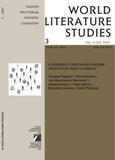Stratení v hľadaní nového (Poznámky k úlohe otvorenosti kultúry voči opakovaniu)
Lost in the Quest for Novelty. (Remarks on the Role of Openness of the Culture to Repetitions)
Author(s): Marek Suwara, Jan Werszowiec PłazowskiSubject(s): Literary Texts
Published by: Ústav svetovej literatúry, Slovenská akadémia vied
Keywords: Opakovanie; Kopírovanie; Duševné vlastníctvo; Intelektuálna krádež; Nové médiá; Repetitions; Copying; Intellectual Property; Intellectual Theft; New Media
Summary/Abstract: Repetitions can be analysed from various perspectives: historical, moral, legal, commercial etc. Their evaluation varies depending on the point of view one chooses to adopt. For instance, plain repetition (copying) can be considered a theft from moral perspective, while in the same time it can be considered beneficial from the perspective of culture propagation. Repetitions, even those which are not innovative, are crucial for the propagation of culture. Moreover, they show that the idea, the tune, the composition and other elements of cultural objects have a real impact on the development of the culture. From the perspective of memetics, such repetitions are necessary for the memes to survive and the tendency to repeat those “memes” constitutes their fitness to cultural environment. To be closer to biological analogy one should recognize those repetitions as replications. From such perspective the program of reducing replications through the means of “prohibition” becomes not only absurd and unreachable but also it would significantly slow or even push the process of evolution backwards. One should notice that any restrictions on copying were absent in various historical periods. For instance, one of the most important ideals of culture in Middle Ages was exact copying and preserving the works of the Antique, obviously without any permission of the authors or their successors. Not much later hermeneias constituted the canon of the icon painting; without which the latter lacked their “natural” value. There is a lot of similar examples. It is not until the time when the artistic value becomes reduced to its commercial value that the problem of an intellectual theft arises. Whatever the concept of an intellectual property should mean it is an example of self-contradicting definition. No artist works in an intellectual vacuum, thus no one has the full rights to the composition. There are two main reasons for such introducing the concept of an intellectual value. The first is the liberalization of the society leading to its decay into individuals aiming at their own interests. The other is the rapid growth of the “new media” technology, which allows for mindless copying – disregarding any justification or understanding. The latter is not a big problem due to the error elimination in the process of evolution. The former, however, as leading to the disintegration of society is really dangerous. In the nature it would result in the species extinction. In the culture some similarities can also be seen and will be analysed in the present paper. One should make a clear distinction between the plain copying and educational practice which helps to preserve the most important “memes” from disappearing but it covers only a small space of cultural developments. On the other hand innovations are the equivalent for genetic mutations, which allow for the creation of new species.
Journal: World Literature Studies
- Issue Year: V/2013
- Issue No: 3
- Page Range: 26-38
- Page Count: 13
- Language: English

